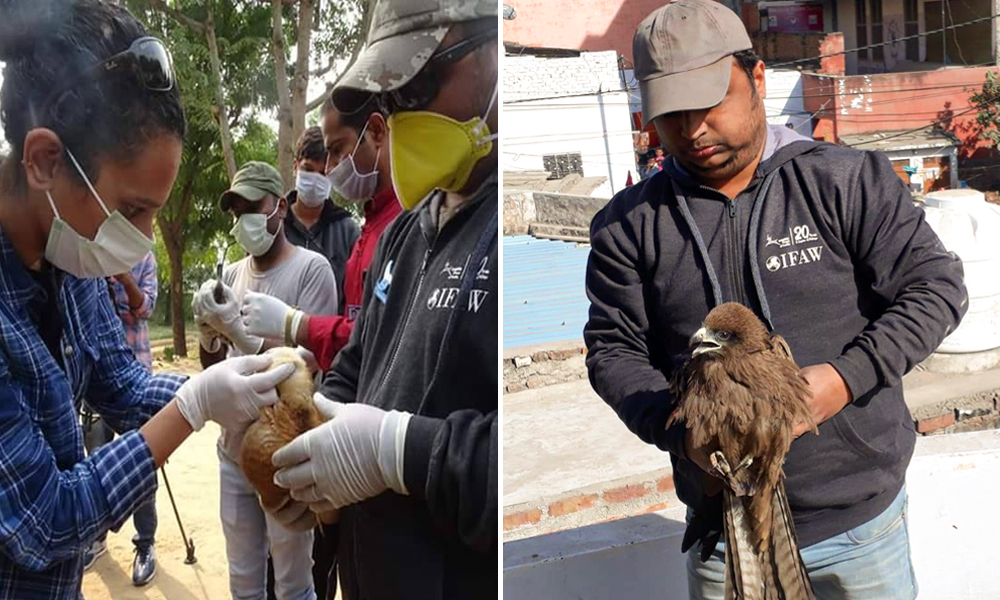
This Environment Activist & His Team Rescued Over 350 Birds During Jaipur Kite Festival
17 Jan 2020 9:40 AM GMT
Editor : Prateek Gautam |
A free soul who believes that journalism, apart from politics, should stand for social cause and the environment.
By : Reethu Ravi
Reethu, a story teller, a person often found between the pages of a book or contemplating the nuances of life.
In a span of three days, Hope and Beyond has rescued over 350 birds including black kites and pigeons.
Amidst the frenzies of flying kites and people savouring their bite of festive sweets during Makar Sankranti, there is a bunch of individuals that go to the nooks and crannies of Jaipur to help the birds injured during the kite festival.
The members of Hope and Beyond - a Non-Government Organisation (NGO) that work towards the welfare of the environment and all things living - give a new life to the birds injured during the ever-popular kite festival of Jaipur.
"When birds get tangled in the strings, they get severely injured. Recently, we found few birds whose wings were completely chopped off. They are grounded for life, only because of someone's need for enjoyment," says Dr Joy Gardner, a wildlife conservationist, environment activist, and founder of Hope and Beyond.
36-year-old Gardner, who has been involved in the field of wildlife conservation for nearly two decades, started Hope and Beyond in 2015.
This year, the team has set up a bird treatment camp consisting of 17 veterinary doctors. In a span of three days, they have rescued over 350 birds including black kites and pigeons.
The organisation also works towards avoiding human-wildlife conflicts in the region that is prone to infiltration by leopards and other wild animals from nearby forest areas. In addition, they were involved in bird rescues during the Sambhar lake incident where more than twenty-five thousand birds lost their lives because of avian botulism. Along with the state government and some other organizations, Hope and Beyond rescued more than 1200 birds and saved more than 550 migratory birds from Sambhar lake.
How The Kite Festival Proves Fatal To The Birds
"Kite flying is fatal for thousands of innocent birds that get injured by glass-coated threads that cut and entangle to cause fractures, wing cuts, nerve injuries, and even glass pieces embedded in their bodies," says Gardner.
"With more kites competing for space with birds, the number of injuries have increased over the years. What makes matter worse is that people continue to use dangerous strings, with no regard to the harm they cause the birds," he adds.
When asked about the ways to reduce the injuries to birds, Gardner explains, "First, people should stop using Manjha. Next, people should avoid flying kites in the morning and evening hours. This is the time when most of the birds take flight in search of food. The best way is to stop kite flying altogether, if possible."
People can also switch to cotton or nylon strings, which are not as harmful to the birds. However, people prefer Manjha as the kite festival also constitute competitions.
"The problem is with humans and the solution is also with humans. The sky is their (the birds) home and I think we should give right of way to these birds," says Gardner.
Stressing on the need to stop large-scale kite flying, Gardner adds, "Sankranti is a festival of giving. To celebrate the festival, you can use the money spent on Manjha and kites, to donate gifts to the poor; that is the actual way of celebrating the festival. While I love the festival, my only issue is with flying kites. Why is it necessary to fly kites? Kite flying has nothing to do with anybody's religious sentiments. No religious literature mentions this."
Free Bird Treatment Camp
Throughout Jaipur, the volunteers of Hope and Beyond, equipped with rescue kits, stay on the lookout for any injured birds. When spotted, the volunteers waste no time in rushing to help the wounded birds.
The NGO carries out both on-the-spot first aid by rescuers and intensive surgeries by trained veterinarians at the camps. This is followed by rehabilitation and release of the birds.
"When we see a bird getting hit, we always try to rescue the bird within 10 to 15 minutes. Once we stop blood loss, it is easy to save the bird," says Gardner.
Once the volunteers rescue the bird, it is administered with first aid on-site, if needed. The volunteer then takes the bird to one of the five camps in the city, where it is tagged securely before undergoing medical treatment. Following this, the bird is taken to the base camp where shelters with major facilities to provide anaesthesia and surgeries are present. Next comes the rehabilitation.
"A proper protocol is followed to rehabilitate the birds. We have set up several aviaries, where no one except the feeder is allowed entry. The feeder cleans and feeds the birds. The aviaries are covered from all sides to ensure that the birds do not see anyone. We also maintain proper quarantine," explains Gardner.
Once the birds get better, they are given line-practice. "Different perching heights are installed inside the aviaries for analysing wing recovery and flight patterns. These are installed at various heights, the farthest being 8 feet. A wildlife biologist then observes how high the bird can fly. If it can fly 8 feet, then it is fit to be released," he explains.
They also maintain a detailed observation chart for each bird, following which proper treatment is administered. Light-weight plastic tags are fixed on their feet to identify the bird and treat it as per the severity of its injuries. Once they are fit to fly, they are released at various habitable locations. Those that cannot fly are handed over to the Jaipur Zoo.
Every year during the kite festival, Gardner and his team rescue around 700 birds in a month's time. Today, the organisation has over 40 members and over 100 volunteers.
This year, during the festival, around 80 kite flying camps were set up across Jaipur with nearly 1000 bird fatalities. In addition, two people lost their lives and over 200 were injured in kite-related accidents. "Is harming both humans and animals is what a festival is supposed to mean?" asks Gardner.
Also Read: 'Give Food, Clothes, Employment, Not Money': A 26-Yr-Old Tamil Man Is Challenging Beggary
 All section
All section














